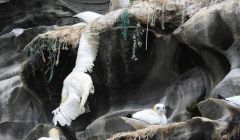Nature / Plastic is built into nearly all North Atlantic gannet colonies
A STUDY has highlighted the threat marine plastic poses to the North Atlantic’s largest seabird.
Researchers studying northern gannet populations across the UK, Norway, Iceland, Canada, the Faroe Islands and Ireland found that birds in 28 out of 29 colonies had incorporated plastic into their nests.
Scientists at the University of the Highlands and Islands, the Natural History Museum and the University of Tasmania used digital photography, visual observation and existing publications to gather data.
A total of 7,280 nests were examined, with 46 per cent found to contain debris. The majority of the debris was threadlike plastics, thought to originate from fishing activities.
Project leader Dr Nina O’Hanlon said: “Marine plastic pollution is an increasing and global environmental issue which poses a threat to marine biodiversity. There has been a rise in research on plastic ingestion, but data on nest entanglement is still limited due to challenges in monitoring this in the marine environment.
“An alternative option to monitoring entanglement or entanglement risk is to look at nest incorporation of plastic.”
O’Hanlon, an ornithologist at North Highland College UHI’s Environmental Research Institute, added: “This study has highlighted the scale of the issue across the geographic range of northern gannets.
“It also indicates that plastics are more frequently incorporated in nests in well-established colonies in areas with high levels of fishing activity. This means that gannets are a useful species to help us monitor fishery related debris and the effectiveness of actions which are introduced to reduce this.”
RSPB Shetland sites manager Kevin Kelly said that the problem was not as bad in Shetland as some coastal areas further south.
He said that shags, which were a coastal species, also had a problem with plastic in their nests. Kelly said that between the wide-ranging gannets and the more coastal birds the plastic, much of which was fishing debris, could come from a wide area, including inland.
Become a member of Shetland News
Birds, he said, thought the brightly coloured plastic was seaweed and took it for nesting use. When it breaks down it is more inclined to become tangled on feet or around necks. Birds thus encumbered often die of starvation.
Kelly said that Shetland had wonderfully clean beaches and a brilliant voluntary record of tidying up – with projects like the Voar Redd-Up.
He added: “Everyone has a responsibility. Whether it is recycling or cleaning up beaches, which Shetland is great at.”
He said that it was impossible to know where the rope and plastic bits came from, but there was a collective responsibility to stop discarding plastic – one offender is the plastic wrappers from the top of six-pack or four-pack cans.
Dr Alex Bond, the senior curator in charge of birds at the Natural History Museum, was also part of the study team. He said: “Gannets use the same nest over several years and we were able to show that colonies that had become established earlier had more plastic in the nests, highlighting the persistent nature of plastic pollution.”
Researchers at the University of the Highlands and Islands launched a citizen science project in July to gather information on birds which have become entangled in debris or which have incorporated it into their nests. To contribute or find out more visit, www.birdsanddebris.com.
For more information about the Environmental Research Institute, visit https://eri.ac.uk
Become a member of Shetland News
Shetland News is asking its many readers to consider paying for membership to get additional features and services: -
- Remove non-local ads;
- Bookmark posts to read later;
- Exclusive curated weekly newsletter;
- Hide membership messages;
- Comments open for discussion.
If you appreciate what we do and feel strongly about impartial local journalism, then please become a member of Shetland News by either making a single payment, or setting up a monthly, quarterly or yearly subscription.









































































